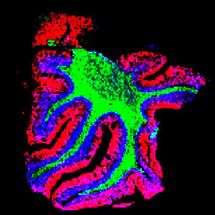Microbes on the move
New method to search for extraterrestrial life: TU Berlin researchers discover simple test method to identify microbial movement
Movement is one of the clearest signs of life. Researchers at TU Berlin have now discovered that certain microbes react specifically to a chemical substance and actively move towards it - a principle that could help to detect life on other planets in the future. Their findings could have a decisive impact on space missions, as the new method is not only simple, but also fast and cost-effective.
The team led by Dr. Max Riekeles from the Astrobiology research group at TU Berlin was able to show that the targeted movement of microorganisms can be used as a biosignature. The scientists studied three different types of microbes - two bacteria and an archaeon - and found that they all move towards the amino acid L-serine. This movement, known as chemotaxis, is a response to chemical stimuli and is used by microbes to find food sources.
"Our results suggest that the movement of microbes could be a valuable method for detecting life on other planets," explains Max Riekeles. "In particular, if life on Mars has a similar biochemistry to that on Earth, L-serine could serve as an attractant." This means that a simple test based on the movement of microbes could provide evidence of life without the need for complex chemical analyses.
Robust microorganisms as a model for extraterrestrial life
The microorganisms studied were specifically selected for their resistance to extreme environmental conditions. The highly motile bacterium Bacillus subtilis can survive temperatures of up to 100 °C in spore form. Pseudoalteromonas haloplanktis was isolated from Antarctic waters and thrives at temperatures from -2.5 °C to 29 °C. The archaeon Haloferax volcanii belongs to a group that is similar to bacteria, but genetically different from them. It lives in high-salinity environments such as the Dead Sea.
"Bacteria and archaea are two of the oldest life forms on Earth, but they move in different ways and have evolved motility systems independently of each other," Riekeles explained. "By testing both groups, we can make life detection methods more reliable for space missions."
The researchers used the amino acid L-serine to make the microbes move. Previous studies have already shown that L-serine is a chemotactic stimulus for many organisms from all domains of life. It is also suspected that L-serine exists on Mars. If life there has a similar biochemistry to that on Earth, it is conceivable that L-serine could attract potential Martian microbes.
A simple and cost-effective method
The research team developed a simplified test method based on a two-part chamber with a membrane. Microbes are placed on one side, while L-serine is inserted on the other side. If the microbes are alive and motile, they swim through the membrane to the food source. "This method is simple, inexpensive and does not require complex tracking methods," says Riekeles.
The special feature of this approach lies in its simplicity: instead of carrying complex measuring equipment, an experiment of this kind could be carried out directly on a space probe or a Mars rover. Researchers would then be able to use a single photo of the chamber system to determine whether potential microorganisms on an alien planet react to chemical stimuli without having to detect complicated chemical traces.
Future prospects for space missions
The method has the potential to significantly support space missions. "If we develop it further, it could be a valuable addition to existing techniques for detecting life on other planets," explains Riekeles. The next steps include miniaturizing the technology and testing it under simulated space conditions.
Another advantage of this method is that it consumes little energy and requires little human intervention. This is particularly important for space missions where resources are limited. If the method proves successful in further tests, it could be used in future Mars missions.
Note: This article has been translated using a computer system without human intervention. LUMITOS offers these automatic translations to present a wider range of current news. Since this article has been translated with automatic translation, it is possible that it contains errors in vocabulary, syntax or grammar. The original article in German can be found here.




















































